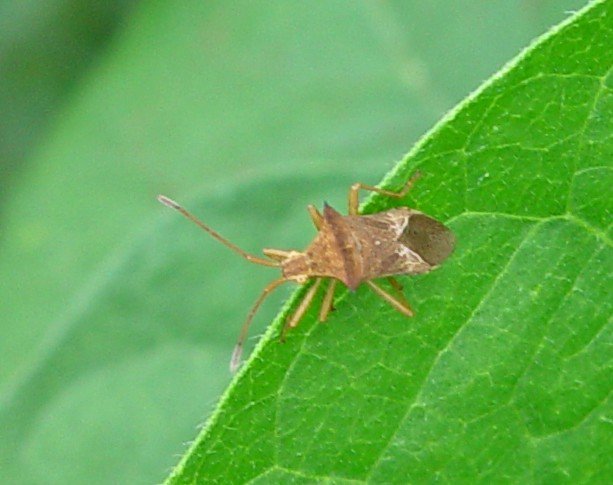Credits: Biovision-Infonet

(c) A.M. Varela, icipe

(c) Georg Goergen, www.ecoport.org
There are several pod sucking bugs. The tip wilter (Anoplocnemis curvipes), the spiny brown bug (Clavigralla tomentosicollis, Riptortus bugs (Riptortus dentipes), Mirperus jaculus, the green stink bug (Nezara viridula) and Aspavia sp.
These bugs attack cowpeas in Africa. The spiny brown bug Clavigralla tomentosicollis and Riptortus dentipes are the most important, causing serious damage.
Nymphs and adults attack young, tender pods and causing shrivelling and rotting of pods and malformation of seeds, which lose viability.
Bugs are difficult to control since they usually feed on a wide range of crops and are very mobile.
What to do:
- Control weeds to destroy roosting sites.
- Monitor crops regularly. A threshold of 2 bugs/metre row has been recommended as a guideline for bug control in Ghana (GTZ/PPRSD).
- Conserve natural enemies such as assassin bugs, spiders, praying mantises and ants. These are important natural enemies of bugs. They kill or deter bugs. Conserve and attract predatory natural enemies to your crop by planting flowering plants.
- A number of plants (lantana, garlic, oleander, African marigold, blackjack, goat weed, wormseed, among others) are reported as effective repellent crops against various species of bugs (Elwell and Maas, 1995).
- Alghali (1991) reported an integrated pest management strategy for cowpea production. In Nigeria, intercropping with sorghum reduced the numbers of Riptortus bugs in cowpea significantly.
- Bugs can be collected by hand regularly and killed, especially during flowering and pod formation.
- A commercial formulation of neem (Neemix(r)) gave effective control of stink bugs on cowpeas. This product was applied three times at the beginning at pod formation using 210 g azadirachtin per hectare (Abudulai et al., 2003).
- Pyrethrins are recommended for control of sucking bugs in organic production in USA (Layton, 2004).